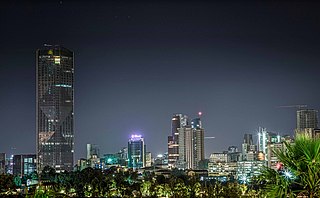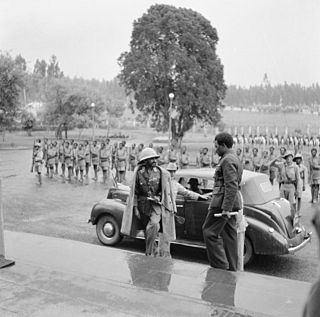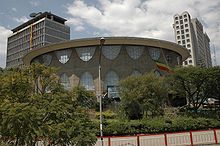
Addis Ababa is the capital and largest city of Ethiopia. In the 2007 census, the city's population was estimated to be 2,739,551 inhabitants. Addis Ababa is a highly developed and important cultural, artistic, financial and administrative center of Ethiopia. It is widely known as one of Africa's capitals.
Rail transport in Ethiopia is done within the National Railway Network of Ethiopia, which currently consists of three electrified standard gauge railway lines: the Addis Ababa–Djibouti Railway, the Awash–Weldiya Railway and the Weldiya–Mekelle Railway. Other lines are still in the planning phase. There is also an urban light rail system in the country's capital, the Addis Ababa Light Rail.

Access to water supply and sanitation in Ethiopia is amongst the lowest in Sub-Saharan Africa and the entire world. While access has increased substantially with funding from foreign aid, much still remains to be done. Some factors inhibiting the achievement of these goals are the limited capacity of water bureaus in the country's nine regions, two city administrations and water desks in the 770 districts of Ethiopia (woredas); insufficient cost recovery for proper operation and maintenance; and different policies and procedures used by various donors, notwithstanding the Paris Declaration on Aid Effectiveness.

The history of Addis Ababa, capital of Ethiopia, formally begins with the founding of the city in the 19th century by Ethiopian Emperor Menelik II and his wife Empress Taytu Betul. In its first years the city was more like a military encampment than a town. The central focus was the emperor’s palace, which was surrounded by the dwellings of his troops and of his innumerable retainers. In the 1920s, Addis Ababa experienced a significant economic upturn, marked by a surge in the number of middle-class-owned buildings, including stone houses furnished with imported European furniture. The middle class also introduced newly manufactured automobiles and expanded banking institutions. Urbanization and modernization persisted during the Italian occupation, guided by a masterplan aimed at transforming Addis Ababa into a more "colonial" city, a trajectory that continued beyond the occupation. Subsequent master plans, formulated from the 1940s onward with the input of European consultants, focused on the development of monuments, civic structures, satellite cities, and the inner city.

Yeka is a district (sub-city) of Addis Ababa, Ethiopia.

Ethiopia–Kenya relations are bilateral relations between Ethiopia and Kenya. The two nations maintain primarily trade ties.
Burayu is a city and special census zone in the Oromia Region of Ethiopia, located directly adjacent to the national capital city Addis Ababa. With the rapid growth of the capital in recent decades and urban sprawl, the town has faced considerable economic and demographic pressures. The city's population has grown from merely 10,000 people in 1994 to an estimated 130,000 people three decades later; consisting of migrants from the rural south of Ethiopia looking for work along with former residents of Addis Ababa who sought cheaper housing in the surburbs.
Dagmawit Moges Bekele is an Ethiopian politician who was Minister of Transport and Communications of Ethiopia from October 2018 to 14 January 2023. Dagmawit became Deputy Mayor of Addis Ababa in July 2018. She began working as AU's Peace Fund Secretariat since March 2023.
Beautifying Sheger is a project sponsored by the Ethiopian government that aims to clean rivers and create public works in the capital city, Addis Ababa. It was launched on 27 February 2019 under Prime Minister Abiy Ahmed, and aims to run for three years.
Koye Feche Sub-city is a town in the new Sheger City of Oromia Region, Ethiopia, formerly located in the Oromia Special Zone Surrounding Finfinne.

Urbanization of Addis Ababa began in late 19th century in a site of Finfinne inhabited by various Oromo clans, and Emperor Menelik II formed permanent settlement for his army and nobles. In 1881, he transferred his capital to Entoto, a vicinity area of Addis Ababa, ultimately relocated in Addis Ababa in 1886; he along with his wife Empress Taytu Betul founded it after finding Entoto undesirable due to coldy climate location, and abundance of hot mineral springs believed to have health effects in Addis Ababa. In 1890s, Addis Ababa saw rapid population growth due to factors related to 1889–1892 famine and immigration to the area and mobilisation of traditional militias and other associated immigrants after the Battle of Adwa (1896).
Democratic backsliding in Ethiopia is ongoing, most notably under the administration of Prime Minister Abiy Ahmed. Since assumption of power in April 2018, Ahmed has played crucial role of reforms in the Ethiopian politics and reversal of policies implemented by the former ruling party, the Ethiopian People's Revolutionary Democratic Front (EPRDF). Abiy immediately gained public approval and international recognition owing to liberalized policymaking including in media outlets, gender equality, internet freedom and privatization of economy. Furtherly, he was also warmly gained accolades for ending 20-years conflict between Ethiopia and Eritrea, from which he awarded the 2019 Nobel Peace Prize, being the first Ethiopian to earn the title. In 2019, Ethiopia received a score of 19 out of 100 in the Freedom in the World metric, a significant improvement from previous years, although it is still characterized as "Not Free". In December 2019, he formed the Prosperity Party by dissolution of EPRDF and merged all its ethnic based regional parties while the Tigray People's Liberation Front (TPLF) refused to obey, resulting intense face-off with the federal government. He promised to hold free and fair upcoming election; although due to COVID-19 pandemic deterioration and other security and logistics issues, the election was postponed indefinitely in mid-2020. Opponents called this action as backdrop to "reconsolidate dictatorship" and "constitutional crisis". On 9 September 2020, the Tigray Regional election were held as the federal government deemed illegal election. According to the electoral commission, the TPLF won 98.2% of 152 seats were contested. The federal government and the Tigray authority relations aggravated by late 2020, culminating the Tigray War.

Housing in Ethiopia has been improving over past decades. About 70% of housing units are requiring total replacement whereas 30% are in fair condition. 20–27% are in adequate sanitation and 19.4% in rural areas at national level. However, there are still slum areas particularly in Addis Ababa where 80% of areas experienced sanitation problem and health and safety risks.

Sheger Park, also known as Friendship Park, is the biggest urban park in Addis Ababa, Ethiopia. The park is right next to Unity Park Sheger Park was opened on 10 September 2020, in the presence of high-level Ethiopian government ministers, the president, the prime minister and the first lady.
Many buildings have been demolished by the government of Ethiopia under Prime Minister Abiy Ahmed since early 2019, with 12,000 homes planned to be demolished for the purpose of rebuilding urban sprawl. The project was targeted toward Addis Ababa and Oromia, in the towns of Sebeta, Buraryu, Lagatafo Lagadadi, Sululta, Ermojo, and Gelan. Residents have criticized the government demolition, claiming they paid taxes to the government properties, and the government is illegally taking undue advantage to confiscate for the Oromia government.
Entoto Natural Park is an natural park located northeast of Addis Ababa, Ethiopia on the southeastern slopes of Mount Entoto, covering an area of 1,300 hectares. It is situated at an altitude of between 2,600 and 3,100 meters.

Sheger City is a proposed model of urban development established on 22 October 2022 that centers around the city Addis Ababa to provide influence and economic benefit for other satellite cities. The administration contains 12 sub-cities, 36 districts and 40 rural kebeles with its seat located in Saris area in Addis Ababa.
The Addis Ababa City Corridor Project, also known as Smart City Project, is an ongoing urban planning project in the city of Addis Ababa initiated by the Addis Ababa City Administration in December 2022 to upgrade key routes and improve connectivity among the corridors. Due in 2025, the project aims to expand metropolis that incorporates the construction of bicycle routes, spacious pedestrian walkways, better roads, parks, libraries, and additional housing.
Chaka Project is an ongoing urban planning project and part of Addis Ababa City Corridor Project, known as Smart City Project launched on 21 May 2022. The project encompasses the construction of National Palace, residencies, resorts, artificial lake and renovation of forest in Yeka sub-city of Addis Ababa, Ethiopia.
Jantirar Abay is an Ethiopian politician who is the deputy mayor of Addis Ababa since 2020. He was the Minister of Urban Development and Housing from 2018 to 2019. On 26 April 2019, he was appointed as advisor to the Prime Minister on Infrastructure & Urban Development. On 18 April 2019, Jantirar was replaced by Aisha Mohammed as minister of Urban Development and Construction.














